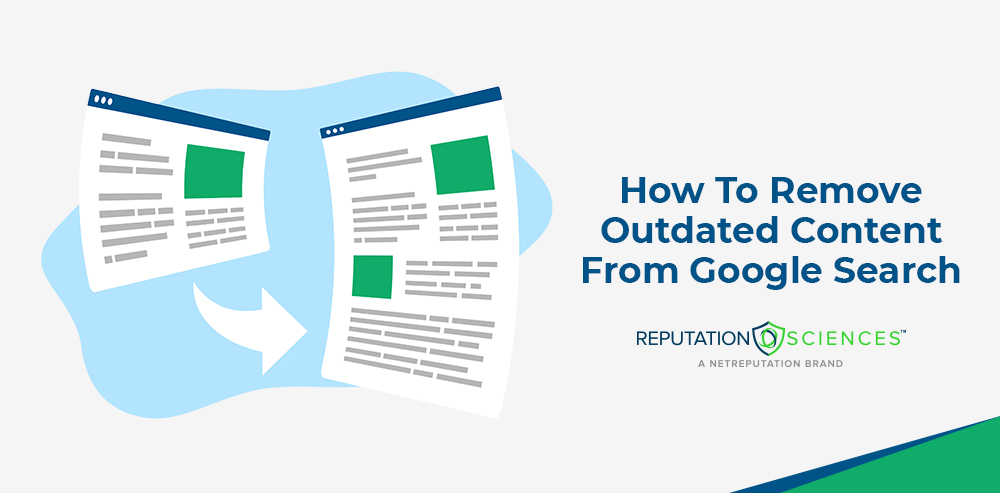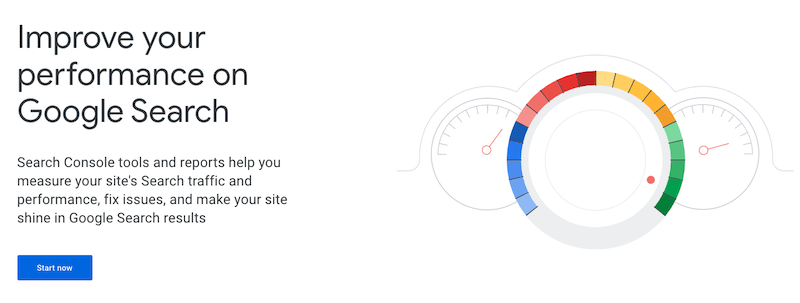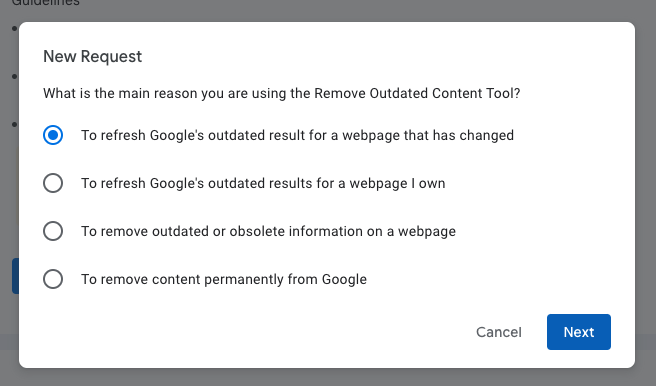How To Remove Outdated Content From Google Search

In this article, we’ll discuss why it’s important to remove outdated content from Google search results and how to go about doing it.
It’s extremely important for every business to constantly manage and keep track of their online presence. One of the ways to boost your site’s popularity is to remove outdated content from Google.
“Outdated content” was introduced as part of a previous Google update. It refers to the content that is irrelevant to your website but still available on search engines.
You can never be sure that the information you’re erasing is actually gone from the internet. Furthermore, there’s no guarantee that another person hasn’t already made a copy of your work.
There are a couple of options for outdated page removal:
- Update the content to make it relevant for your website again
- Request that the content be removed in the event that it’s not worth updating
If you need help deciding whether to update or remove content from your website, Google Analytics and Google Search Console can provide information about your website’s performance. (Note that Google Search Console used to be referred to as Google webmaster tools.)
In this article, we’ll explain the methods for removing outdated content from Google search results so you can fine-tune your website’s online presence.
If you need immediate help removing information from Google or taking control of your online reputation, contact our experts today.
What Is Outdated Content?

All irrelevant content and outdated pages that stay on your company website and are available in Google’s search results are considered outdated content.
For example, search results for discounted services or products that are no longer available are considered outdated content. Additionally, content with a high bounce rate or a low click-through rate (CTR) may be considered outdated.
In general, if any of your content shows up in search results and it’s old or irrelevant, you can think of it as outdated content.
Why Should You Manage Outdated Content?
Conducting regular audits of your content and updating your blog posts, pages and metadata can help keep outdated content at bay. This can keep the subject matter current and refresh SEO when new keywords should be used.
Both your website’s SEO and Google’s index function best when your content is high-quality, relevant and either timely or evergreen. It’s important to keep your content and website organized to improve the user experience and make it easier for web crawlers to find and index your content.
Here are three reasons that site owners should stay on top of their content.
Your Content Is More Likely To Appear in Search Results
Neglecting your website and published content makes it difficult for Google and other search engines to crawl your website and return your content in search results. Removing or refreshing some of your outdated and irrelevant content will help Google focus on the content that matters most.
You Could Lose Business If You Have Outdated Content
Irrelevant or outdated information on a live page can mislead your customers, often resulting in unmet expectations. This can have the unfortunate side effect of receiving bad reviews, which can damage your online reputation.
Another outcome is that potential customers or clients don’t bother contacting your business because they don’t know what you offer or because they think you offer different products or services than you actually do.
You May Need To Adhere to Industry Regulations
Regulated industries have to remain compliant with laws and regulations even as they change. If you don’t update your content, you could provide incorrect information to your audience and possibly get into legal trouble for not having the correct framework in place.
Is online content hurting your reputation? Get in touch with us today for help developing the perfect strategy for your business’ ORM.
What Should I Know About Removing Out-of-Date Content?

If you’re considering the removal of outdated pages and posts for some of the content on your website, here are a few expert suggestions:
- Some content can be made highly relevant to your audience with a heavy update. If a page on your site is still getting good traffic or has the potential to attract people, updating it is a solid choice.
- When irrelevant content is dragging your website down and holding it back from growth, it’s better to opt for deleted pages than trying to update them.
- There are times when you need to remove information or images for legal purposes.
- If content has already been deleted permanently, such as pages or images, you’ll want to use the Refresh Outdated Content tool or a similar tool so Google can update its index.
Here’s another use case for the Refresh Outdated Content tool: You sold your website, and the new site owners haven’t deleted the old content yet. If the information continues to appear in search results even though it’s no longer relevant and could be misleading, you can request that Google remove it.
When Is Removing Content a Bad Choice?
As discussed, submitting a removal request to Google for outdated content that’s not important or causing harm is a smart strategy.
However, there are definitely situations when removing your content isn’t the best option. Here are the times when removing URLs submitted to Google isn’t a good idea and you should instead opt to retain that content.
- The content is useful, relevant and continues to bring a good amount of traffic to your site.
- A lot of backlinks point to the content, which is hard to achieve and excellent for SEO.
- The content has archival value even if the event, report or stats are not up-to-date.
- You have a pillar page or other type of foundational content that’s in need of an update. Since this type of content forms your site’s structure, it should be updated instead of removed.
- The information has to be retained and available for legal purposes, such as your privacy policy and terms of service.
- There’s a lot of user value in the content even if it has a smaller, niche audience.
Sometimes, the decision to retain versus delete content isn’t so obvious. In these cases, you may need a combination of strategies: Update the content that has the potential to perform well and contact Google to remove the rest.
Using Google Search Console To Remove Content

Google Search Console has tools for requesting that out-of-date content be refreshed in search engine results. Additionally, you can also submit a temporary removal request to hide specific URLs for a limited time.
Search Console also lets you see content and URLs that were reported as outdated by other people. This will give you an idea of the website content that you didn’t realize was hidden and not showing up on Google.
Note that according to Google, you should only use the Refresh tool if you meet the following criteria:
- You don’t own the web page.
- The image or page no longer exists or is very different from the version Google is currently indexing.
However, even if you do own the website, the process for submitting a request is essentially the same because Google will ask you why you’re making the request. From there, it will direct you where you should go.
Here’s how to request that Google remove content that’s no longer serving a purpose.
1. Open the tool.
You can find the Refresh tool here. For more information about it, start here — Google has a detailed overview of the tool, what it can be used for, etc.
2. Open a new request.
Click the blue New Request button to get started.

3. Select the reason why you’re using the tool.
A pop-up box will ask why you want to use the tool. Select the best option.

4. Enter the URL of the out-of-date content.
While the process will vary a bit based on who owns the content and why you’re submitting a request, at some point you’ll be asked to enter the URL of the content you want taken down.
Note that you can also enter the URL for an image if that’s the type of content you want removed.
5. Follow Google’s directions to complete the process.
Google will guide you to complete the process as needed based on the type of content you’re requesting removal for. For example, you may be asked to enter a phrase that appears in the cached page but is not on the live page.
6. Submit the request.
Once you submit the removal request for the final time, you’ll get a confirmation from Google that your submission was received. You can track its progress via the Search Console.
After you press “Request Removal” for the last time, you will get information from Google that they received your request. You can use Google Search Console so you can keep track of its progress.
How Long Does the Removal Process Take?
It’s common for Google to process removal requests within 24 hours, so you may get confirmation that it’s complete in as little as one day.
It’s also helpful to understand the different statuses for removal requests:
- Pending: The request is being processed, and it may take some time until the status changes.
- Denied: Your request is denied. Expect to receive additional information about why your request was denied.
- Approved: The request is approved.
- Canceled: The request is canceled by the verified site owner or the user.
- Expired: The request is approved but expired. Requests expire 180 days after they were approved or when outdated URLs no longer exist.
The less information you provide, the longer it could take Google to move forward with your request.
Also, while the request may be approved quickly, that doesn’t mean search results will update as fast. It may take several days for your changes to appear. Google’s indexing spider often takes time to crawl the revised site pages.
If you’ve completed the removal process correctly, the changes will eventually be reflected in search results.
Maintain Your Authority and Relevance in Your Niche
Thanks to modern technology and digital tools, it’s now easy to look for content on Google and ask the search engine to remove results that no longer serve a purpose.
Keeping your website updated and showing only reliable and relevant content will help you attract new potential customers. If you use these Google tools properly, they will be able to benefit your website and business in many ways.
If you’re ready to take control of your online content and improve your reputation management strategy, contact Reputation Sciences today. We can help you with outdated page removal and building the digital presence you deserve.
